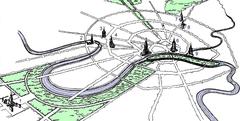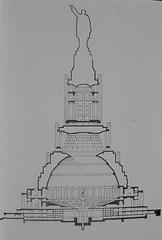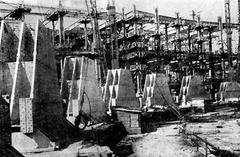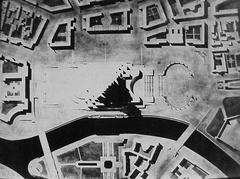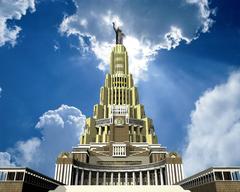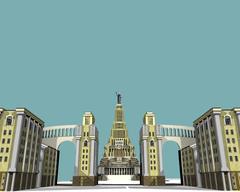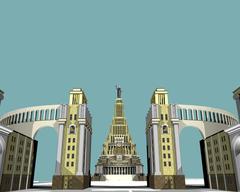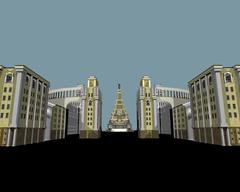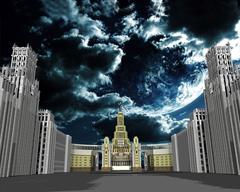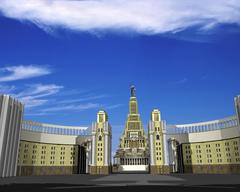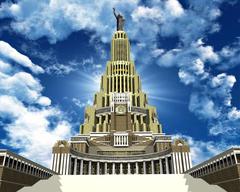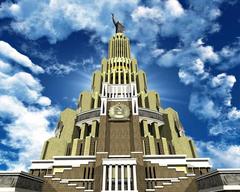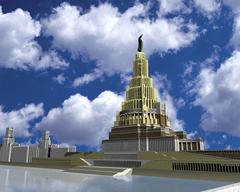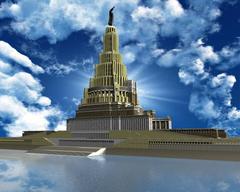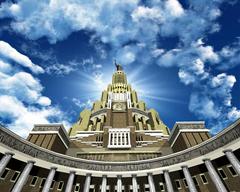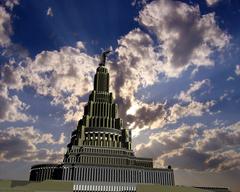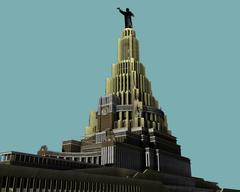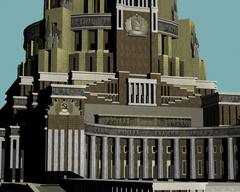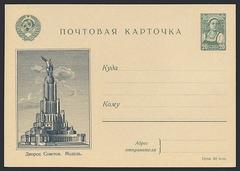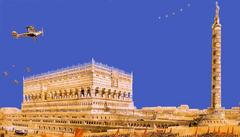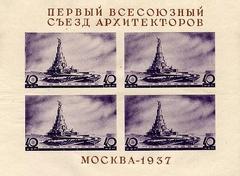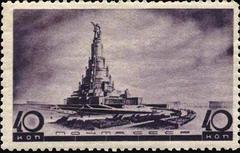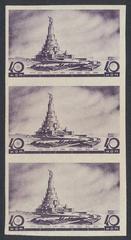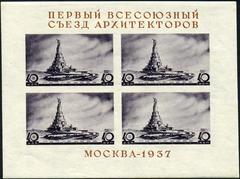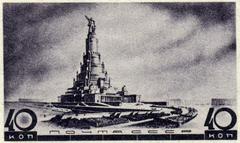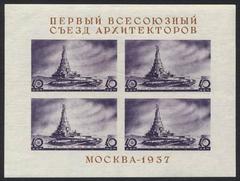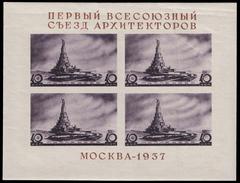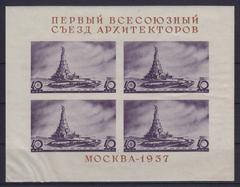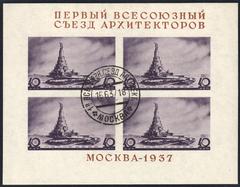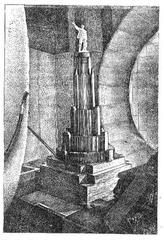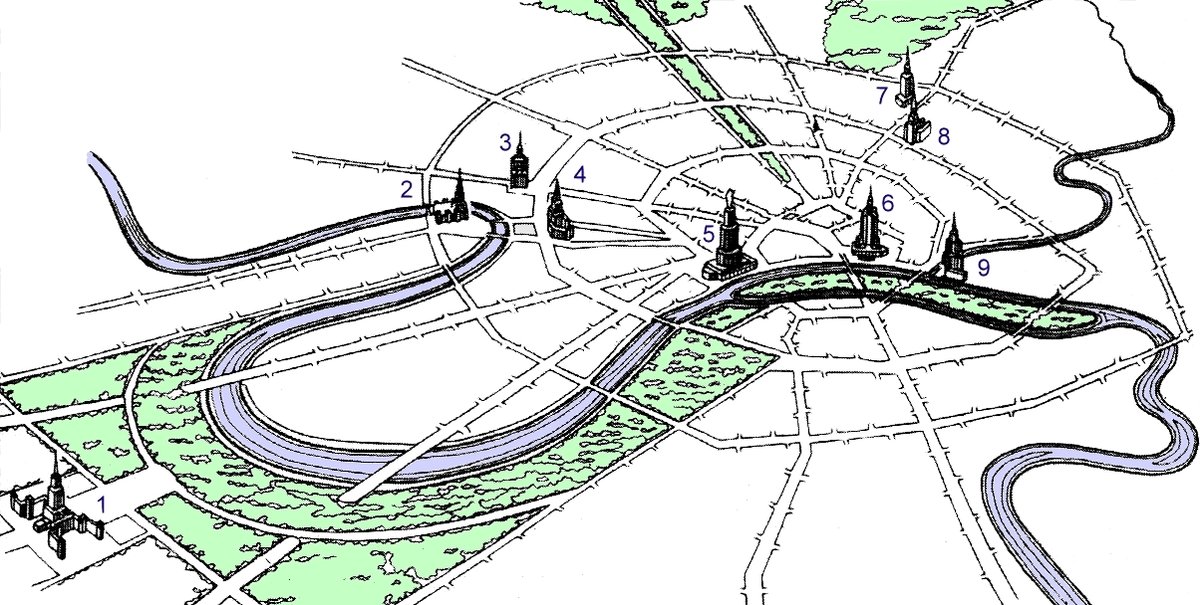
Palace of the Soviets, Moscow: Visiting Hours, Tickets, and Visitor Guide
Date: 14/06/2025
Introduction
The Palace of the Soviets stands as one of the most spectacular “what ifs” in architectural history—a grand vision of Soviet power and ideology that was never realized, yet continues to shape Moscow’s cultural memory and cityscape. Conceived in the 1930s as a bold symbol of Communist authority, the Palace was designed to be the tallest building in the world, a monumental hub for state events, and a centerpiece of Stalinist architectural ambition. Although the project was halted and ultimately abandoned, its legacy endures through the reconstructed Cathedral of Christ the Saviour that now occupies its intended site, nearby Stalinist skyscrapers, and a wealth of museum exhibits and guided tours. This comprehensive guide details the Palace’s history, architectural vision, political symbolism, current visitor experiences, practical tips, and key resources for travelers seeking to explore this iconic chapter of Moscow’s past (museumstudiesabroad.org; Harvard Eurasia Omeka; Russia Beyond).
Table of Contents
- Introduction
- Historical Background: Conception and Political Context
- Architectural Plans and Symbolism
- Construction, Abandonment, and Aftermath
- The Site Today: Visitor Information
- Tickets, Hours, and Accessibility
- Guided Tours and Nearby Attractions
- Tips for Visitors
- Frequently Asked Questions (FAQ)
- Visuals and Interactive Resources
- Conclusion
- References
Historical Background: Conception and Political Context
The Palace of the Soviets was envisioned during a period of rapid transformation in the Soviet Union. In 1931, after the demolition of the original Cathedral of Christ the Saviour, Soviet authorities launched an international competition to design a structure that would serve as the physical and ideological heart of the new socialist state. Boris Iofan’s winning design, developed with Vladimir Shchuko and Vladimir Gelfreikh, called for a 415-meter (1,362-foot) skyscraper—an audacious feat that would eclipse all contemporary buildings and serve as a statement of Soviet modernity and supremacy (museumstudiesabroad.org).
The palace was intended as the venue for major state events, including the Congress of Soviets, symbolizing the centralization of power in Moscow. Its planned location—on the very site where the great cathedral had stood—was a deliberate assertion of the regime’s ideological break from the past (Harvard Eurasia Omeka).
Architectural Plans and Symbolism
Iofan’s design envisioned a tiered skyscraper in the Stalinist Empire style, blending neoclassical grandeur with cutting-edge engineering. The structure was to be topped by a 100-meter (328-foot) statue of Vladimir Lenin, making it both the tallest building and the tallest statue in the world at that time. The main assembly hall would seat over 20,000 delegates, surrounded by elaborate marble and granite interiors, vast staircases, and monumental columns (Harvard Eurasia Omeka).
The Palace’s imposing scale and lavish ornamentation were not merely aesthetic choices; they were political statements. The planned Lenin statue would dominate Moscow’s skyline, serving as a perpetual reminder of Soviet ideology. The project’s ambition signaled the USSR’s determination to lead not only politically and economically, but also culturally and architecturally (historywanderer.com).
Construction, Abandonment, and Aftermath
Demolition of the original cathedral began in 1931, and construction of the Palace started with the completion of its massive concrete foundation by 1939. However, technical challenges, the enormity of the task, and the outbreak of World War II in 1941 brought the project to a standstill. The steel frame already erected was dismantled and used for wartime defenses as resources were redirected to the war effort (museumstudiesabroad.org).
After the war, the Soviet Union faced new priorities and economic realities. The Palace project was quietly abandoned, and in the 1950s, its foundations were transformed into the Moskva open-air swimming pool, once the largest heated outdoor pool in the world. In the 1990s, with the fall of the Soviet state, the site was cleared for the faithful reconstruction of the Cathedral of Christ the Saviour, completed in 2000 (russiable.com).
The Site Today: Visitor Information
Although the Palace of the Soviets was never built, its legacy lives on at the site now occupied by the Cathedral of Christ the Saviour. The cathedral, a faithful reconstruction of the 19th-century original, is a must-see for visitors interested in Moscow’s architectural and political history. The site is centrally located near the Kremlin and Red Square, making it easily accessible for tourists.
What You Can See
- Cathedral of Christ the Saviour: Open to visitors daily, the cathedral features richly decorated interiors, an observation deck with panoramic views of Moscow, and historical exhibits referencing the palace project.
- Historical Markers and Museum Exhibits: Nearby museums, such as the State Historical Museum and Museum of Moscow, offer displays on the Palace of the Soviets and Stalinist architecture (Express to Russia).
- Seven Sisters Skyscrapers: These Stalin-era buildings reflect the architectural style and scale influenced by the Palace’s design (Express to Russia).
Tickets, Hours, and Accessibility
- Cathedral Visiting Hours: Generally open daily from 10:00 AM to 6:00 PM (may vary on religious holidays).
- Tickets: Entrance to the main cathedral is free. Access to the observation deck requires a ticket (approx. 300 RUB). Discounts are available for children and seniors.
- Guided Tours: Guided tours of the cathedral and its observation deck are available in Russian and English. Specialized tours focusing on Soviet history or “Unbuilt Moscow” may be arranged (Touropia).
- Accessibility: The cathedral and grounds are generally accessible to visitors with mobility challenges, though some areas may have steps or uneven surfaces.
Guided Tours and Nearby Attractions
- Official Cathedral Tours: Provide insight into the site’s religious, political, and architectural history.
- Specialized Walking Tours: Several operators offer tours focusing on Soviet architecture, including the Palace of the Soviets’ history and its influence on the city (Never Was Magazine).
- Nearby Sites:
- Pushkin State Museum of Fine Arts: A short walk away, with rich art collections.
- Patriarch’s Bridge: Offers excellent views of the cathedral and the Kremlin.
- Red Square and the Kremlin: Major attractions within easy reach.
Tips for Visitors
- Dress Code: Modest attire is required inside the cathedral. Women should cover their heads; men should remove hats.
- Photography: Allowed in most outdoor areas and from the observation deck, but may be restricted inside the cathedral during services.
- Language: English signage is present at major sites, but Russian predominates. Consider a translation app or hiring a guide.
- Best Times to Visit: Spring and early autumn offer pleasant weather. Major holidays may affect hours and crowd levels.
Frequently Asked Questions (FAQ)
Q: Can I visit the Palace of the Soviets?
A: The palace was never built, so there is no structure to visit. The site is now home to the reconstructed Cathedral of Christ the Saviour.
Q: What are the visiting hours for the cathedral?
A: Typically open from 10:00 AM to 6:00 PM daily, but hours may change during religious holidays.
Q: Do I need a ticket?
A: Entry to the main cathedral is free. Tickets are required for the observation deck and some tours.
Q: Are guided tours available?
A: Yes, both general cathedral tours and specialized Soviet history tours are available.
Q: Is the site accessible for people with disabilities?
A: The cathedral and grounds are generally accessible, though some areas may have steps.
Visuals and Interactive Resources
To enrich your visit and understanding:
- Explore online virtual tours and high-quality images of the Cathedral of Christ the Saviour, the Seven Sisters skyscrapers, and historical renderings of the Palace of the Soviets.
- Interactive maps and digital resources are available on Moscow tourism sites, helping you plan your route and learn more about the city’s architectural heritage.
Conclusion
The Palace of the Soviets remains a powerful symbol of Soviet ambition, a touchstone for debates about ideology, architecture, and the shaping of urban identity. Though it was never built, its intended site—now marked by the restored Cathedral of Christ the Saviour—offers visitors a window into Moscow’s layered history. By exploring the cathedral, nearby museums, and participating in themed tours, travelers can engage with the story of the palace and its impact on the city’s evolution. For a deeper discovery, make use of digital resources, join specialized tours, and explore the broader context of Moscow’s Stalinist architecture.
Download the Audiala app for curated guides, maps, and up-to-date visitor information, and follow our social channels for more on Moscow’s historical sites and hidden gems.
References
- Palace of the Soviets: History, Architecture, and Legacy of Moscow’s Unbuilt Monument, 2025, Museum Studies Abroad (museumstudiesabroad.org)
- Palace of the Soviets: History, Symbolism, and Exploring Moscow’s Soviet Architectural Legacy, 2025, Harvard Eurasia Omeka (Harvard Eurasia Omeka)
- Palace of the Soviets: Visiting Hours, Tickets & History of Moscow’s Iconic Site, 2025, Express to Russia (Express to Russia)
- Visiting the Palace of the Soviets Site and Moscow Historical Sites: Hours, Tickets, and Tips, 2025, Touropia & Russia Beyond (Touropia), (Russia Beyond)
